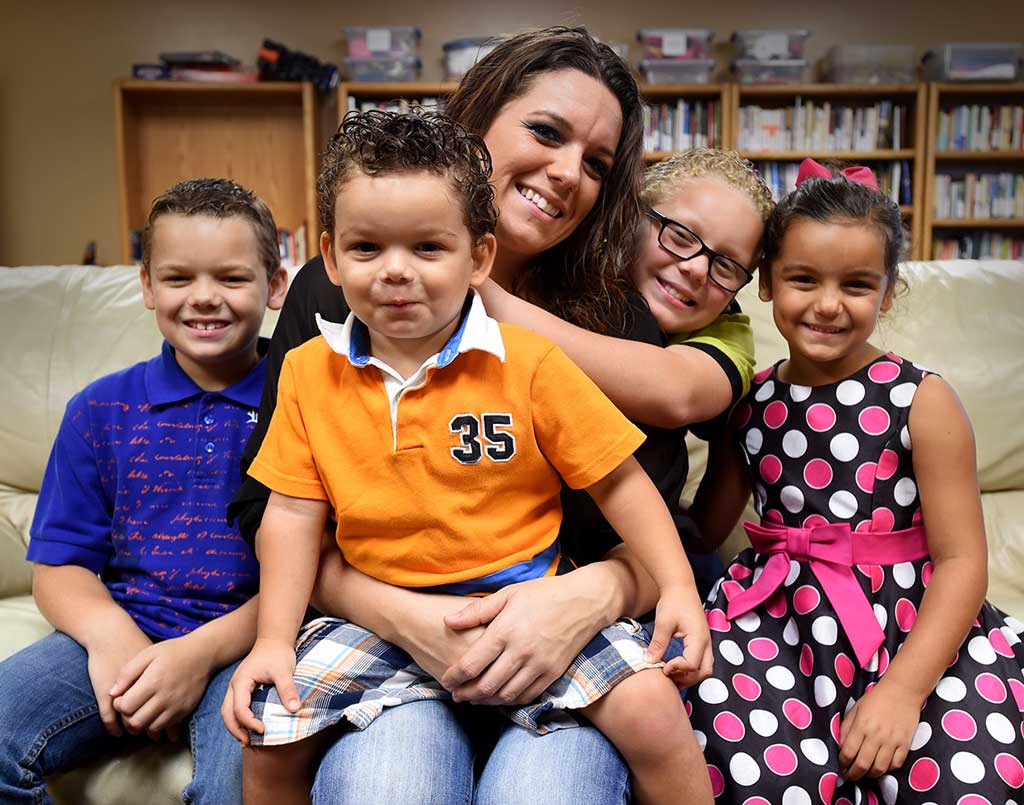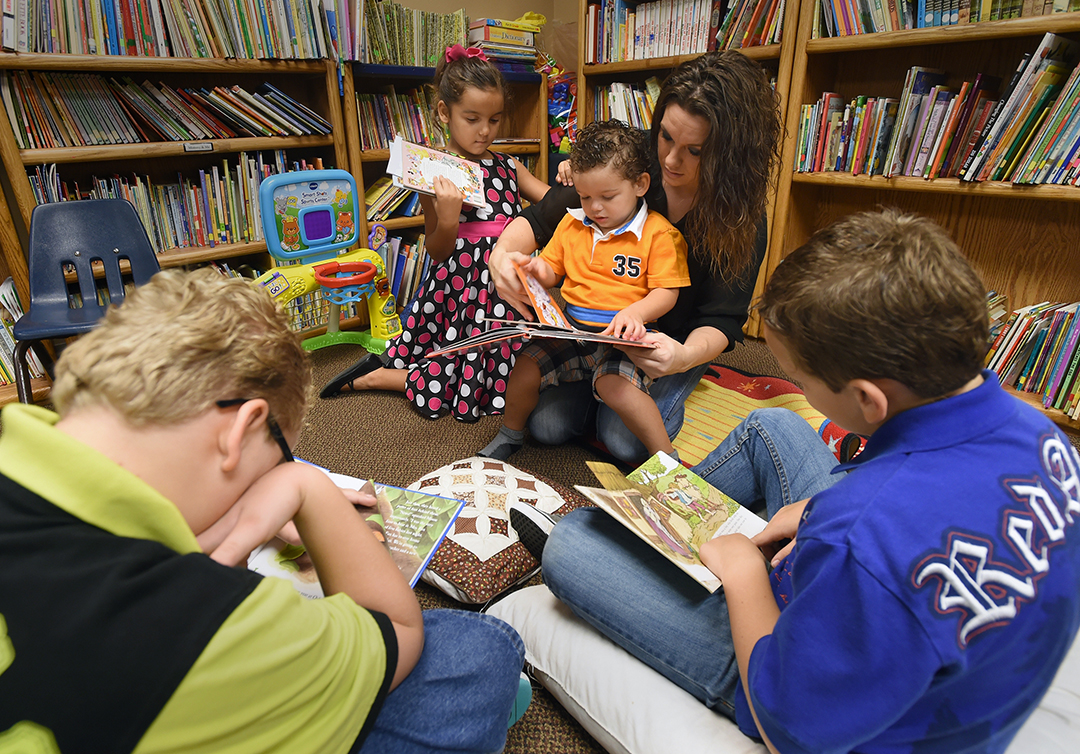
Hunger a top concern for students
By Sara Drumm / The Ledger
Two years ago, the Price family traveled some 4,700 miles from their home in Alaska to a new life in Florida. A new life where everything was opposite – their location on the continent, the weather, daily life.
Meggan Price had just divorced her husband, the father of their four children. She worried about keeping her family together, whether her kids would make friends at their new schools, whether they would keep their grades up, how she would support them after years as a stay-at-home mom.
Her son Titan, 9, remembers it as a time where he missed his friends and his grandma. He remembers that the family didn’t have much to do, much to call theirs – or much to eat.
“Now we’re OK,” he said. “We have food and furniture.”
Price has family in the area, but living together did not work out. After bouncing around a couple times, the family is now working toward a new life at Lighthouse Ministries’ residential center for women and children. The family is one of thousands in Polk County who live in poverty, the subject of The Ledger’s five-part series “Poverty’s Widening Grasp.”
Titan’s experience with hunger is far from unique in a county where many struggle to eat enough each day. Feeding America estimated in 2013 that 38,290 children in Polk – 27 percent – live with food insecurity.
Hunger can cause a variety of mental and behavioral symptoms, including anxiety and aggression. It gnaws at a child’s attention and focus.
“We want a kid at school who’s ready to learn,” said Kathy Pickett, a dean at Mulberry Middle School. “But if you’re asking a child a question about a book, and he’s hungry, all he’s going to be thinking about is, ‘How can I get food?’”
Several programs exist to feed children in need, but there are still gaps.
Titan receives free lunch through his school. But there could be other students at the school who need free lunch and don’t get it because of the paperwork required or because of the social stigma.
The Polk County School District has been working to identify schools that qualify for the Community Eligibility Provision. If a school predominantly serves students from low-income families, it might qualify to provide free lunch and breakfast for all students in the school. Parents don’t have to fill out any paperwork.
Extra: Access to groceries challenging for some
“It eliminates a lot of red tape,” said Kim Van Hook, an assistant principal at Sandhill Elementary School in Haines City.
In 2014-15, 77 Polk schools qualified for CEP. This school year, 109 qualify.
Last school year, eight Polk schools were part of a new program where breakfast was delivered to the classrooms. That eliminates one barrier: getting students to school early enough to eat before classes begin.
Sandhill Elementary was one of the test schools. Van Hook said it helped because the school has a large attendance zone, and buses sometimes don’t arrive until class is starting. In the past, students would sometimes have to choose between missing class and eating.

“Children who are hungry are tired and don’t feel well,” Van Hook said. “To have the opportunity to come in and get breakfast and then lunch, you know at least the child has gotten some decent nutrition that day.”
Mulberry Middle is one school that will have free lunch and breakfast for all of its students. Last year, Mulberry also distributed SmilePaks – backpacks full of food donated by Agape Food Bank to help students who otherwise might spend the weekend hungry.
During the 2014-15 school year, 20 schools provided SmilePaks to those in need and 67 schools gave out kidsPACKs, which are similar to SmilePaks.
Mulberry was also a Summer BreakSpot site. The BreakSpots offer free meals and snacks to children 18 and younger — part of the U.S. Department of Agriculture’s summer food service program.
This summer, 41 schools and numerous other sites were BreakSpots.
Part of the challenge with feeding children in Polk is the size of the county, said Kim Mowatt, Central Florida programs coordinator for Florida Impact, an organization that works to reduce poverty and hunger throughout the state.
“It seems like compared to other counties, Polk is very different,” Mowatt said. “Polk has a lot of territory to cover, and that’s one of the things people have been talking about.”
Some mobile Summer BreakSpots have been added in an attempt to reach children in unserved communities.
Extra: Help for struggling seniors in short supply
Mowatt said she thinks that is an important step.
In 2013, she said, 63,657 students were eligible for free or reduced-priced lunch – but, on average, only 3,647 students participated in the summer feeding program. Are the other 60,000 students eating? If so, what are they eating?
“Unfortunately, there are kids who go to sleep hungry at night,” Mowatt said. “But people are coming together and really putting their heads together on how they can make change.”
Part of the problem is identifying those who are hungry. According to Feeding America, unemployment is a better indicator of hunger than poverty. That means it lurks in nice neighborhoods, in nice houses with empty fridges – not just in run-down areas or on the streets.
“We have to first understand that hunger is invisible; it can be everywhere,” Mowatt said. “In the past people have had their own assumptions of what hunger looked like, but it’s not true anymore. It’s affecting people everywhere. The face of hunger is changing, and we have to understand that.”
Another barrier to identifying hunger is that as students get older, they often feel embarrassed or ashamed of asking for help.
“Once students are older, they not only have to overcome the whole hunger issue, but then they become concerned about what their peers think, and they’re stigmatized,” said Susan Ehrhart, Polk County School District’s school nutrition director.
Having schools offer free breakfast and lunch to all students helps break down that barrier, she said. About 20 middle and high schools that did not offer that last year will now, thanks in part to a better system of identifying families who qualify for government assistance such as food stamps.
Dee Dee Wright, homeless liaison for the School District, said the programs are great for those who can access them. However, she still hears from families who are desperate for food.
“I can’t say that I think it’s enough,” she said.
Kim Long, director of Agape Food Bank, said the community has to keep working together to alleviate childhood hunger.
“We need to focus on children, so they can focus on school,” she said. “It’s not a dirty secret. We need to solve it.”